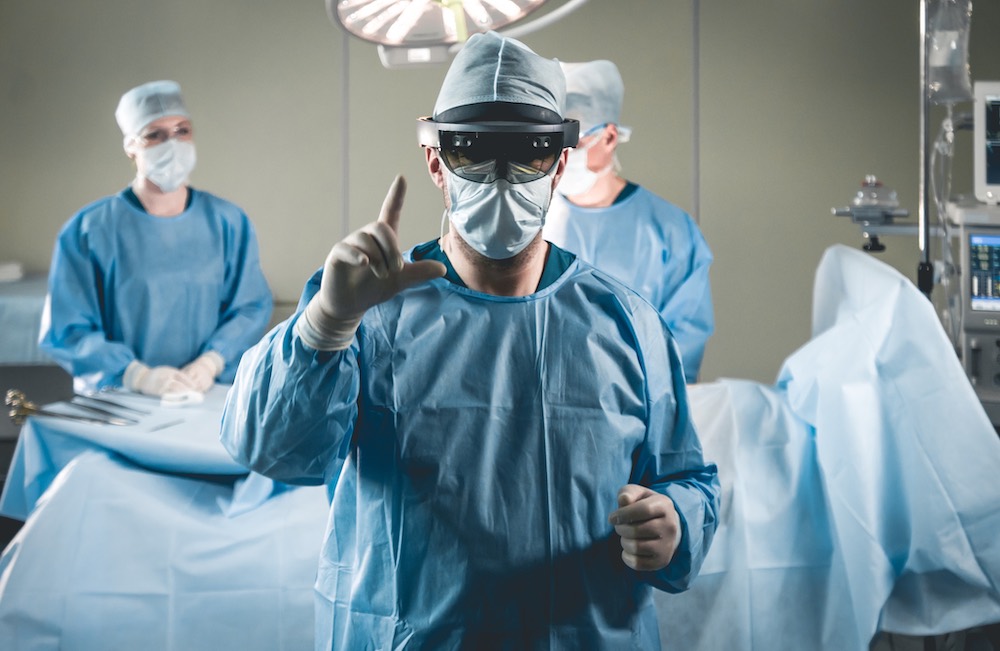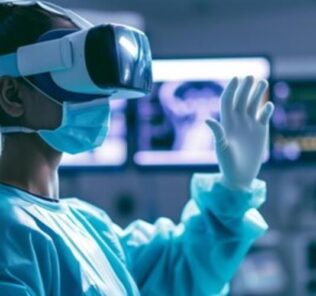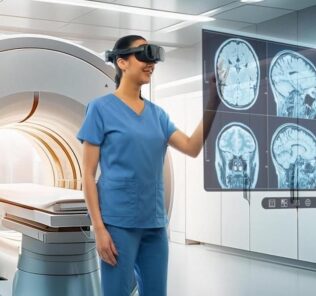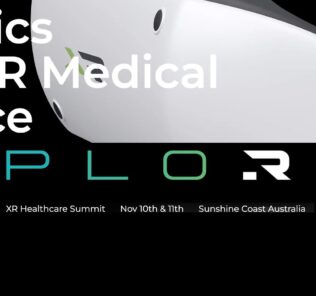Use of XR in Spinal Surgery and Incorporation of Surgical Theater Tool
The Hoag Health System recently reported that “the future of spine surgery is here.” This is because the first augmented reality (AR) spine surgeries in Orange County, California were recently performed using the recently FDA-approved SpineAR technology. The technology was co-developed by neurosurgeons from Hoag’s Pickup Family Neurosciences Institute and medical visualization platform leader Surgical Theater. This HealthySimulation.com article shares more about the SpineAR technology and the work Hoag has done to push forward augmented reality surgical simulation.
Ultimately, SpineAR’s hologram-like reconstruction of the body allows surgeons to make precise pre-planned surgical decisions down to the millimeter. According to the health system, using multiple displays inside a single set of AR goggles creates real-time 3D feedback and ensures the accuracy of instrument placement and surgical motion.
Hoag shared that this enhanced view will “result in more efficient surgeries, streamlined surgical planning, less exposure to X-rays, and optimal surgical precision.” Further, the view should also enable the training of existing and future spine surgeons while deploying Hoag’s technological capabilities to hospitals anywhere.
Sponsored Content:
Previous HealthySimulation.com Hoag Coverage
In the past, HealthySimulation.com has worked alongside Robert G. Louis, MD, FAANS, Chief of Neurosurgery and Director of Extended Reality (XR) Development at the Pickup Family Neurosciences Institute at Hoag Memorial Hospital. In 2022, he led off the Champions of Simulation Virtual CE/CME Symposium with the presentation titled, “It Isn’t Brain Surgery: Using Simulation to Improve Patient Conversion, Understanding, Outcomes, and Satisfaction.” During this discussion, which provides 1 Nursing CE Certificate Contact Hour, Louis noted current problems with traditional imaging systems and described how advanced medical visualization systems can solve them.
“Surgeons, like athletes, have what we call flow,” Louis said. “Every time we have to break attention from what we’re doing and focus on something else, we lose the flow. It distracts us because of context switching. With AR, I have this heads-up display that allows me to increase spatial awareness and maintain focus on the patient the entire time.”
Additionally, in 2021 at the annual AWEXR, in Santa Clara, California, Louis showcased his use of both VR training tools to better understand complex neurological anatomy (ie brain tumors) for both clinical intervention as well as patient education. He demonstrated a real-time augmented reality overlay, utilizing Surgical Theater, to see visual reminders of patient anatomy in real-time. Through the use of cutting-edge neuroimaging and neuro-navigational equipment, Dr. Louis utilized the concept of keyhole neurosurgery, minimizing the damage to the surrounding brain, and vascular and soft tissue structures.
Sponsored Content:
Ultimately, Dr. Louis believes that most brain and skull base tumors can be resected through small openings or by utilizing naturally occurring orifices. This approach has been demonstrated to decrease post-operative pain, minimize neurologic complications and shorten the length of hospitalization, resulting in better outcomes for his patients.
Since 2015, Dr. Louis has been involved with the development and implementation of Virtual and Augmented Reality technologies for pre-operative simulation and rehearsal and intraoperative navigation. The 3-D VR/AR platform is provided by Surgical Theater and was developed based on flight simulator technology from F-16 fighter jets. This technology allows the surgeons to literally rehearse complicated operations in virtual reality; affording them the opportunity to visualize critical anatomy and navigate potential pitfalls. The results are making the operations safer and more effective for patients. Under Dr. Louis’ guidance, Hoag Neuroscience Institute has become the highest-volume center for Augmented Reality in Neurosurgery in the United States.
The advantage of VR is the ability to simulate multiple different approaches. In the virtual model, we can do two plans, three plans, five plans and see what is best for the patient — and so because we have done the pre-op rehearsal I already know where the important surgical structures are going to be,” Louis said. “We experience life in 3D, why should our medical care be any different? We do not let pilots fly without training on simulation and we should not let people operate on our brains without simulation.”
Related HealthySimulation.com Webinar: Extended Reality in Brain Surgery: Addressing Current Problems with Innovative XR Technologies
Presented by Robert G. Louis MD, FAANS, this one-hour, intermediate CE webinar presents current problems with traditional imaging during neurosurgical interventions and describes how advanced medical visualization, particularly in the Mixed Reality (XR) simulation space, can solve them. The importance of medical imaging cannot be understated. Medical imaging plays an important role not only as a diagnostic tool but also as a therapeutic and interventional aid. Advances in imaging and medical visualization systems, particularly in the Extended Reality (XR, includes Virtual Reality, Augmented Reality) space, have revolutionized physician-patient communication as well as medical education and resident training. Learning objectives of this webinar include:
- To illustrate how XR can be used across the surgical treatment continuum from patient education, surgical planning, and intraoperative visualization.
- To demonstrate the proven value proposition of Extended Reality in helping deliver better patient care and improved healthcare training.
- To discuss current problems with traditional imaging systems and how Extended Reality can solve them.
More About Surgical Theater
Surgical Theater is a virtual and augmented reality-based healthcare services company that combines cutting-edge fighter jet flight simulation technology with a patient’s own anatomy scans. This is achieved through the use of medical imaging such as MRI, CT, and DTI, to create a 360°-3D virtual reality reconstruction of the patient’s own anatomy and pathology. The company’s precision VR revolutionizes patient engagement opportunities in the clinic while providing cutting-edge surgical planning and navigation capabilities in the operating room, as well as powerful tools for medical education and collaboration. Hoag was recognized among the Best Regional Hospitals in the 2022-2023 US News & World Report.
More About The Hoag Health System
Hoag’s world-class healthcare system offers comprehensive care for families’ every need. The healthcare system is driven to achieve the highest level of medical standards and outcomes through relentless recruitment of top physicians and unrivaled investment in leading health innovation. Empowering the people, partners, and communities the healthcare system serves defines a unique approach to health leadership and underpins the mission to build the best healthcare future for all.
Learn more About Surgical Simulation
Lance Baily, BA, EMT-B, is the Founder & CEO of HealthySimulation.com, which he started while serving as the Director of the Nevada System of Higher Education’s Clinical Simulation Center of Las Vegas back in 2010. Lance is also the Founder and acting Advisor to the Board of SimGHOSTS.org, the world’s only non-profit organization dedicated to supporting professionals operating healthcare simulation technologies. His co-edited Book: “Comprehensive Healthcare Simulation: Operations, Technology, and Innovative Practice” is cited as a key source for professional certification in the industry. Lance’s background also includes serving as a Simulation Technology Specialist for the LA Community College District, EMS fire fighting, Hollywood movie production, rescue diving, and global travel. He and his wife Abigail Baily, PhD live in Las Vegas, Nevada with their two amazing daughters.
Sponsored Content:





















